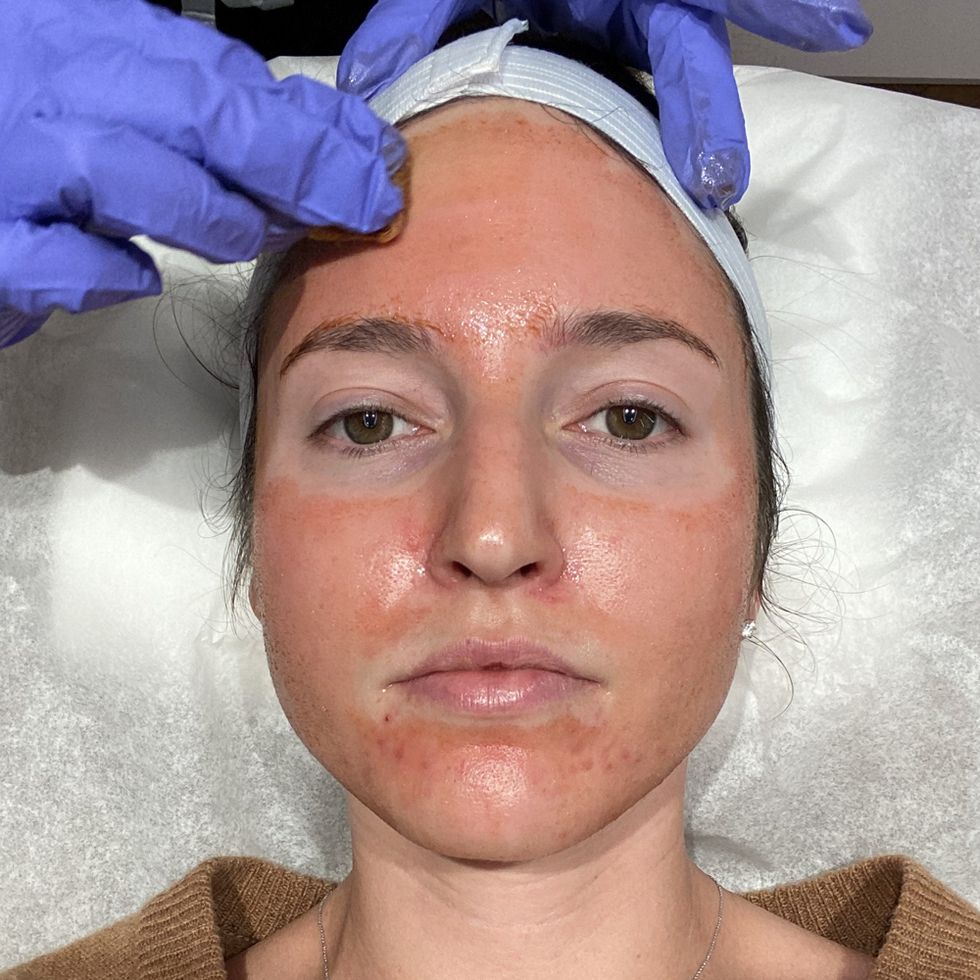A VI Peel is a chemical peel of medium depth designed to permeate the outer layer of your skin, known as the epidermis, and extend into the dermis below. It uses a proprietary product developed by Vitality Institute Medical Products.
Similar to other chemical peels, the VI Peel functions by removing dead skin cells and prompting the generation of new proteins. This treatment is frequently employed to address signs of aging, refine skin texture, and rectify issues related to pigmentation. VI Peels are sufficiently gentle to be applied safely on various areas such as the face, chest, eyelids, hands, and back. According to Vitality Institute, this peel is suitable for all skin types and shades.
The VI Peel solution comprises a combination of ingredients, including:
- Trichloroacetic acid (TCA) (10 to 12 percent)
- Phenol (10 to 12 percent)
- Salicylic acid (10 to 12 percent)
- Vitamin C (4 percent)
- Tretinoin (0.1 to 0.4 percent)
Benefits of VI Peel
The advantages provided by a VI Peel are akin to those offered by other light to medium chemical peels. Here are some of the typical conditions it addresses.
1. Fine Lines and Wrinkles
Chemical peels dissolve the outer layers of skin cells, prompting the body’s natural healing process and stimulating the production of new collagen and elastin. These proteins are vital for skin structure and elasticity, and their decline contributes to wrinkle formation. However, it’s important to note that VI Peels and similar superficial to medium-depth peels are not effective for treating deep wrinkles or sagging skin.
2, Sun spots and discoloration
Chemical peels have the potential to lighten areas of skin darkened by sun damage or conditions like melasma. Phenol, a key ingredient in VI Peels, is highly effective for treating freckles and discoloration.
3. Keratosis pilaris
Certain active ingredients in VI Peels, such as salicylic acid, can help alleviate the bumps associated with keratosis pilaris, a common condition characterized by clogged hair follicles and skin bumps resembling plucked chicken skin.
4. Acne treatment
VI Peel and other light to medium chemical peels are commonly used to address acne issues. While chemical peels are generally well tolerated and potentially effective for acne treatment, further research is required to optimize their use for this purpose. Chemical peels can combat acne by reducing oil production, eliminating bacteria, decreasing inflammation, exfoliating the outer skin layer, and reducing the number of clogged pores. Salicylic acid, a key component of VI Peel, is also regarded as one of the most effective treatments for acne scars (1).
Side Effects and Precautions
VI Peels are generally well received by most individuals. Nonetheless, some individuals may encounter adverse effects, including:
- Risk of infection
- Skin discoloration
- Swelling
- Dryness of the skin
- Inflammation
- Formation of blisters
- Itching
- Sensations of burning pain
- Redness
- Allergic reactions
- Potential scarring
Individuals with darker skin tones face a heightened risk of experiencing skin discoloration following a chemical peel. According to information from the Vitality Institute, VI Peels are deemed appropriate for individuals of all skin types and colors. However, if you possess darker skin, it is advisable to undergo a consultation before the procedure to understand the best strategies for minimizing potential complications.
Pregnancy, estrogen usage, and excessive exposure to sunlight subsequent to the procedure are identified as risk factors for the development of dark spots following a chemical peel.
How does a VI Peel treatment function?
A VI Peel typically lasts around 30 minutes and is typically devoid of discomfort. It employs a combination of ingredients to dissolve the top layer of skin, unveiling the healthier skin beneath.
Although slight variations may exist in individual procedures, the general process involves:
- Cleansing the skin to eliminate impurities and oil.
- Application of the VI Peel solution in two layers.
- Possible sensations of numbness or tingling upon application of the initial layer.
- Skin “frosting” or whitening upon application of the second layer.
- Washing off the peel approximately 4 to 6 hours later.
- Onset of skin peeling around 3 days post-procedure.

VI Peel Aftercare
Approximately 4 to 6 hours after the procedure, and at least one hour before bedtime, it’s recommended to cleanse off the peel using a gentle cleanser and water. Skin peeling typically commences around 3 days post-treatment.
To properly care for your skin post-procedure, adhere to the following:
- Refrain from applying any creams or lotions until the peel is washed off.
- Utilize the “Post Peel Protectant” provided post-procedure two to four times daily.
- Moisturize frequently until the peeling process concludes.
- Avoid direct sunlight during the peeling phase and ensure sunscreen application whenever exposed outdoors.
As for the frequency of VI Peel sessions, it depends on your financial resources and the specific skin condition being addressed. It is advisable to wait at least 4 to 6 weeks between treatments to observe consistent results.
